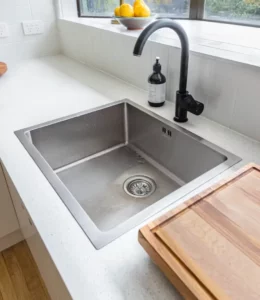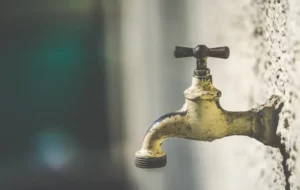There are several possible reasons why your kitchen sink is not receiving hot water. One common cause is a malfunctioning water heater. If the water heater is not functioning correctly or if the pilot light has gone out, it won’t be able to provide hot water to your kitchen sink. Another possible issue could be a problem with the plumbing system. There might be a blockage or a leak in the pipes that supply hot water to your sink, resulting in a lack of hot water flow. Additionally, check if there are any closed or partially closed valves in the hot water supply line that could be restricting the flow of hot water to the sink. It’s also worth considering the age of your water heater, as older units may not heat water as efficiently and may require maintenance or replacement.

Why Does Kitchen Sink Have No Hot Water Pressure?
Read more : Kitchen Colors with Gray Cabinets (Stylish Ideas)
When you experience a lack of hot water pressure in your kitchen sink, it can be frustrating and inconvenient. Several factors could contribute to this problem. One possible cause is a clogged or obstructed aerator. Over time, mineral deposits or debris can accumulate and block the flow of water through the aerator, resulting in reduced pressure. Another potential reason could be a faulty or worn-out cartridge or valve in the faucet. If the internal components of the faucet are damaged or deteriorated, it can hinder the proper flow of hot water and reduce the pressure. Additionally, a blockage or restriction in the hot water supply line, such as a kinked pipe or a valve that is not fully open, can result in diminished hot water pressure at the sink.
How Can I Make My Kitchen Sink Hot Water Faster?
If you’re tired of waiting for hot water to reach your kitchen sink, there are a few things you can do to expedite the process. One option is to install a point-of-use hot water recirculation system. These systems circulate hot water from the water heater to the faucet, ensuring that hot water is readily available without the need for long wait times. Another approach is to insulate the hot water pipes. By adding insulation around the pipes, you can reduce heat loss, allowing hot water to retain its temperature for longer periods and reach the sink faster. Additionally, consider adjusting the temperature setting on your water heater. Increasing the temperature slightly can result in hotter water being delivered to the sink, reducing the time it takes for the water to heat up.
How Do You Unclog A Hot Water Line?
When faced with a clogged hot water line, there are a few methods you can try to restore proper flow. First, check if the aerator on the faucet is clogged. Remove the aerator and soak it in vinegar or a descaling solution to dissolve any mineral deposits or debris. If that doesn’t solve the issue, the clog might be further down the line. You can attempt to flush the line by turning off the water supply, disconnecting the hot water line from the sink, and using a bucket or container to catch any water. Then, turn on the hot water supply briefly to flush out any debris. If the clog persists, you may need to use a plumber’s snake or auger to remove the obstruction. Insert the snake into the hot water pipe and rotate it while applying gentle pressure to break up or dislodge the clog.

How Long Do You Hold The Reset Button On A Hot Water Heater?
The duration for which you hold the reset button on a hot water heater can vary depending on the specific model and manufacturer instructions. In general, you should hold the reset button for approximately 30 seconds to ensure it resets properly. However, it’s essential to refer to the manufacturer’s guidelines or the user manual for your specific water heater to get accurate instructions. Some models may require a shorter or longer duration for the reset process. If you’re unsure or don’t have access to the manual, it’s recommended to contact a professional plumber or the manufacturer’s customer support for guidance.
Conclusion
Having hot water readily available in your kitchen sink is essential for various tasks, from washing dishes to preparing meals. When faced with issues like a lack of hot water, low pressure, or clogs, it’s important to troubleshoot and address the underlying causes promptly. By understanding the possible reasons for these problems and implementing appropriate solutions, such as checking the water heater, unclogging the lines, or making adjustments to the plumbing system, you can ensure a steady supply of hot water in your kitchen sink. Remember to consult professionals when needed, especially if you’re unfamiliar with the repair or maintenance processes associated with your water heating system.
Source: https://gardencourte.com
Categories: Kitchens
